Today we are putting the SanDisk Optimus Ascend 800GB SAS 6.0gbps drive through our quick benchmarks. The SanDisk Optimus ascend series is rated for up to 10 full disk writes per day for five years and a 2.5 million hour MTBF. These figures are above average for SSDs. The Optimus series of SSDs came from SanDisk’s acquistion of SMART Storage Systems in 2013. We previously had the chance to review the Optimus 400GB SAS SSDs both in single drive and RAID 0 configurations. These drives come from a different origin than the Lightning series which came from the Pliant acquisition. Suffice to say, these are well known solid state drives that major OEMs such as IBM have used for some time. As usual, all of our benchmarks to date of SAS and enterprise SATA SSDs are completely non-sanctioned by the companies producing components. SanDisk did not furnish the review sample.
Test Configuration
Since we are going to assume the use of already released hardware, we are using a legacy system for testing across the test suite given that we started the process before the Haswell-EP parts became available.
- Motherboard: Gigabyte GA-7PESH3
- Processors: Dual Intel Xeon E5-2690 (V2)
- SAS Controller: LSI SAS 3008
- RAM: 64GB DDR3L-1600MHz ECC RDIMMs
- OS SSD: Kingston V300 240GB
One quick note here is that we are testing these drives in single port configuration. Drives like the Seagate 1200 do perform significantly worse in single port mode as we saw in the 200GB and 400GB drive benchmarks.
SanDisk Optimus Ascend 800GB Quick Benchmarks
For our quick tests during this part of the series we will just provide the quick benchmarks with only a bit of commentary. The results should be fairly straightforward and the index of previous articles in this series (linked above) is a good resource to compare against. We are adding a few comparison drives to the mix just to give some additional perspective in terms of performance.
AS SSD Benchmark
AS SSD is a solid benchmark that does not write compressible data to drives. The result is perhaps one of the best workstation SSD benchmarks available today.
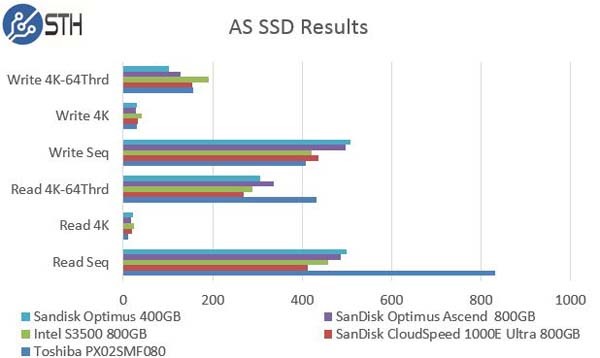
The SanDisk Optimus Ascend 800GB in AS SSD shows a performance bias towards sequential read/ write workloads, and 4K read workloads. It has slightly lower sequential speeds than the 400GB SanDisk Optimus we reviewed previously. The highly threaded random 4K loads favor the SanDisk Optimus Ascend 800GB drive.
CrystalDiskMark
CrystalDiskMark is another benchmark which gives non-compressible read/write numbers. This is in contrast to the ATTO Benchmark used by LSI/ Sandforce and its partners when they market a given solid state drive.
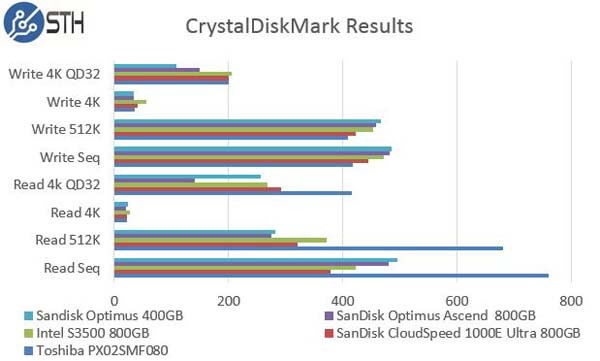
In CrystalDiskMark we see a similar pattern. The Optimus Ascend 800GB drive even bests the Toshiba PX02SMF080 800GB drive on the 12gbps controller.
ATTO Benchmark
The value of the ATTO benchmark is really to show the best-case scenario. ATTO is known to write highly compressible data to drives, which inflates speeds of controllers that compress data like LSI/ SandForce does prior to writing on a given solid state drive. First we will look at read speeds.
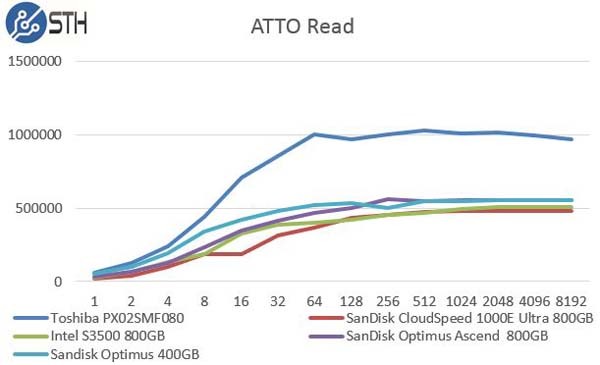
In ATTO we see results with the Optimus Ascend 800GB above other 6.0gbps drives including the SATA drives in our tests.
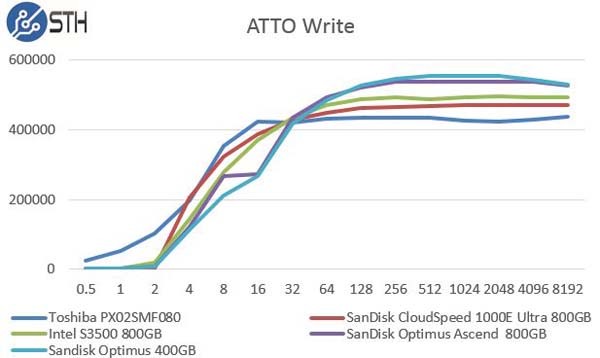
On the sequential write side we can see performance very similar to the original Optimus 400GB drive we tested. The write speeds pick up around the 32k mark and again best even our representative 12gbps drive’s speeds.
Conclusion
The SanDisk Optimus line has always been focused on performance. Thus far, in our testing the drives have performed very well and we have deployed several as part of our new colocation upgrade. We are putting all of our enterprise SSDs through longer sets of testing which we will start publishing the results of shortly. There are still a dozen or so drives we are adding to the data set. For now, the SanDisk Optimus Ascend 800GB drive indeed performs very well and the high write endurance (approximately 14PB worth of writes) is a strong factor in purchasing this drive.

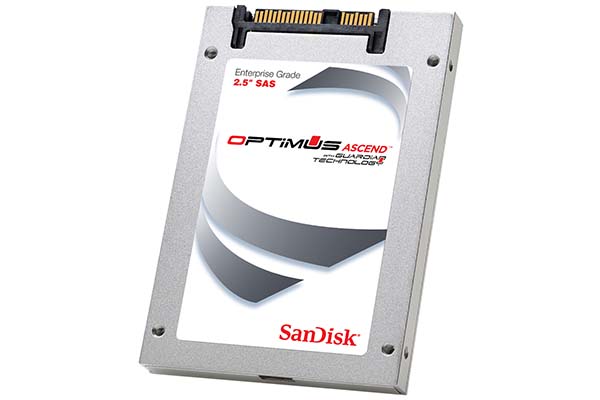



Hey, Patrick:
Look into Dell R720 + 4x Intel P3600 + 2 PMC Sierra NV1600 NVMe NVRAM as ZILs(if you can get your hands on a pair of those). You can put the rest of the SSDs in R720’s 2.5 inch SATA/SAS bays…. That would be a great storage server.